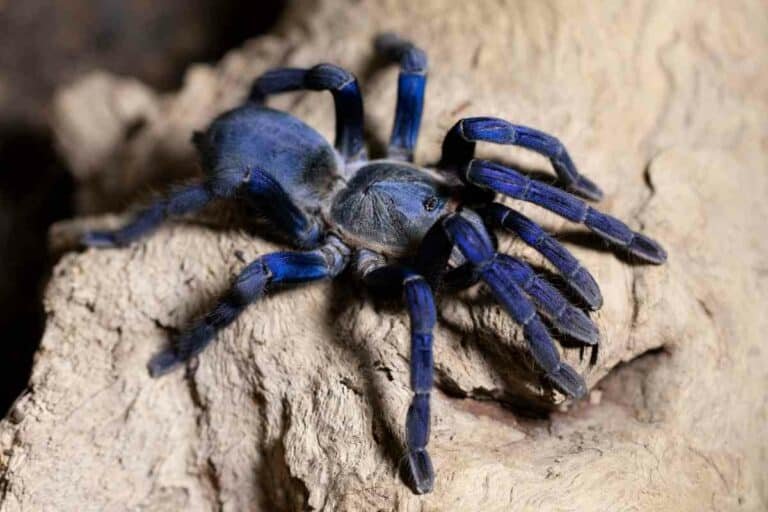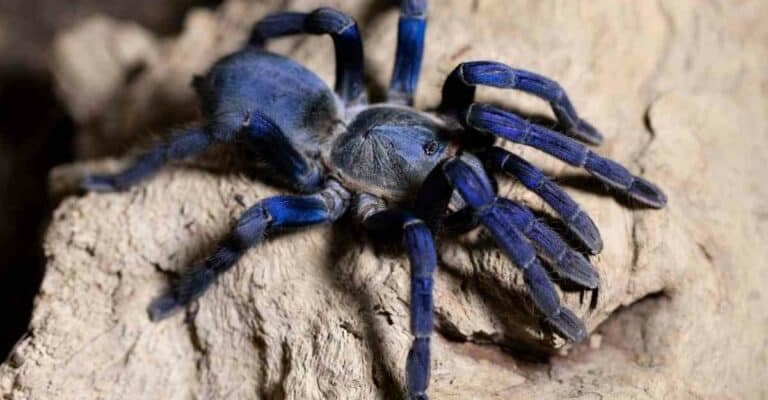
To put it simply, the Cobalt Blue Tarantula, scientifically known as *Haplopelma lividum*, is native to Southeast Asia, particularly Thailand, Myanmar, and parts of Laos. Think of these areas as a lush, tropical paradise, rich in biodiversity—perfect for a spider that thrives in warm and humid environments. But its habitat is more than just stunning scenery; it plays a vital role in the tarantula’s survival and behavior.
Natural Habitat of the Cobalt Blue Tarantula
The Cobalt Blue Tarantula makes its home primarily in burrows found in rainforests and other dense tropical ecosystems. These burrows offer protection from predators and harsh weather, serving as both a shelter and a hunting ground. Imagine a cozy little cave where the tarantula can ambush its prey—this is how it lives most of its life.
Typically, the tarantula digs deep within the ground, creating a web of silk at the entrance of its burrow. This silk acts like a trap for unsuspecting insects that wander too close. The combination of darkness and the unique construction of its burrow provides both safety and a strategic advantage for catching food.
Interestingly, the tarantula often engages in a behavior known as “hiding in ambush.” This means it’ll wait patiently at the entrance, ready to strike at any potential meal that comes within reach. This approach not only conserves energy but also highlights how perfectly adapted the cobalt blue tarantula is to its environment.
Geographical Range
Now let’s talk geography. The Cobalt Blue Tarantula can predominantly be found in Southeast Asia, but it has a varied range across specific regions. Here are some of the primary locations where you might find these striking tarantulas:
- Thailand: The tropical climate of Thailand is a haven for the cobalt blue tarantula. The dense forests provide plenty of moisture and cover.
- Myanmar: This region has similar habitats, and the tarantula can be commonly spotted in the wild.
- Laos: With its lush jungles and warm temperatures, Laos is another critical area where these spiders thrive.
You might be wondering why these spiders don’t venture beyond their home turf. The truth is, their specific environmental needs—like humidity levels and temperature—play a crucial role in their survival. If you took one out of its native region, it could struggle to adapt, leading to stress and health issues.
Climate and Environmental Conditions
The Cobalt Blue Tarantula loves warm and humid conditions. Think about the feeling of a tropical rainforest: warm air, droplets of water, and a rich tapestry of plant life. That’s the ideal climate for these tarantulas, where temperatures often stay between 75°F and 85°F (24°C to 29°C).
The humidity in their environment is essential for keeping their exoskeleton moist, which is crucial for their overall health and shedding process. Without the right humidity, a tarantula can face severe complications. It’s like trying to live in a desert with no water—it simply doesn’t work out!
One common challenge in their environment is the seasonal changes. During the rainy season, the ground becomes soft and moist, allowing for easier burrowing. Conversely, during the dry season, these spiders might remain deeper in their burrows to avoid the heat and preserve moisture. This adaptability is vital for surviving in the wild.
Behavior and Adaptations
You might think spiders are all about spinning webs, but that’s not quite true for the Cobalt Blue Tarantula. Instead of creating webs high in the trees, these tarantulas prefer to dig. Their strong chelicerae (mouthparts) are perfect for excavating soil. This burrowing behavior is just one of the unique adaptations that help them thrive in their environment.
Additionally, their bold coloration serves a purpose beyond beauty—bright colors in nature often communicate that an animal is venomous. This is a clever camouflage strategy that helps to ward off predators. Here’s the thing: while they are indeed venomous, their bite is not typically dangerous to humans. However, it can be quite painful, so it’s wise to admire from a distance!
The Cobalt Blue Tarantula also has an exceptional ability to sense vibrations. They use this skill to detect movements near their burrow, helping them to respond quickly to potential threats or meals. Imagine sitting quietly in your favorite coffee shop, tuning in to every word around you; that’s how these tarantulas stay alert in the wild.
Conservation Status
As for their survival in the wild, the Cobalt Blue Tarantula faces some challenges. Habitat loss due to deforestation and human encroachment is a growing concern. Many parts of Southeast Asia are undergoing rapid development, which threatens the natural habitats of these unique tarantulas.
Another issue to consider is the illegal pet trade. The cobalt blue tarantula’s striking appearance makes it highly sought after by pet enthusiasts. While captive breeding helps meet the demand, the removal of wild populations can affect local ecosystems.
Conservation efforts are becoming increasingly critical to ensure that this beautiful spider continues to thrive in its natural habitat. Protecting rainforests and raising awareness about their ecological importance will help maintain the balance of nature for generations to come.
Final Thoughts
The Cobalt Blue Tarantula is a fascinating creature that showcases the beauty and complexity of nature. Understanding where they are found in the wild—primarily in Southeast Asia’s humid, tropical forests—helps us appreciate their unique adaptations and the challenges they face. From their burrowing habits to their striking appearance, these spiders remind us of the delicate balance within ecosystems.
As we marvel at their beauty and complexity, it’s crucial to remember our role in protecting their habitats. Each step we take towards preserving their environment echoes the story of the cobalt blue tarantula, a testament to the wonders of the natural world. So the next time you see one of these incredible spiders, whether in the wild or in captivity, you’ll know a bit more about their home and the challenges they face in an ever-changing world.

